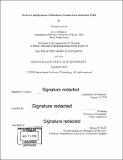Structure and dynamics of membrane proteins from solid-state NMR
Author(s)
Lee, Myungwoon
DownloadFull printable version (32.55Mb)
Other Contributors
Massachusetts Institute of Technology. Department of Chemistry.
Advisor
Mei Hong.
Terms of use
Metadata
Show full item recordAbstract
Solid-state nuclear magnetic resonance (SSNMR) spectroscopy is an essential tool to elucidate the structure, dynamics, and function of biomolecules. This thesis mainly focuses on the structure determination of the hydrophobic domains for fusion proteins which are involved in membrane fusion between the cell membrane and viral envelope. Although extensive structural studies have been conducted on the soluble ectodomain by crystallography, the structural topologies of the hydrophobic TMD of the fusion proteins have been poorly understood. Here, we introduced SSNMR to investigate the secondary structure and oligomeric states of the TMD of two fusion proteins, PIV5 F and HIV gp41. For the PIV5 TMD, the membrane dependent secondary structure was determined by measuring the chemical shifts: predominant a-helical conformation in the POPC/cholesterol membrane shifts to the [Beta]-strand in the POPE membrane. Using 19F spin diffusion experiments on the fluorinated TMD, we have determined that the TMD forms a trimeric helical bundle. For the HIV gp4l MPER-TMD, we found the presence of a turn between the MPER helix and the TMD helix by measuring intramolecular distances and probing the lipid-peptide and water-peptide interactions. Intermolecular 19F- 19F distances of the fluorinated peptides indicate that the MPER-TMD is a trimeric. In addition to membrane fusion proteins, we have studied the oligomeric structure and the zinc-bound coordination geometry of a de novo designed amyloid fibril that catalyzes ester hydrolysis. By measuring the intermolecular contacts, we determined that peptides form parallel-in- register P-sheets and further assemble into stacked bilayers in an antiparallel orientation. The zinc binding sites were confirmed by the chemical shifts perturbation of histidines with zinc and the specific zinc-bound geometry was identified by measuring intra-residue distances of histidines. We also investigated the effects of cryoprotectants on the spectral resolution of lipid membranes and membrane peptides at low temperature. 13C and 1H MAS spectra of various cryoprotected membranes showed that DMSO provides the best resolution enhancement with the best ice formation retardation at low temperature and DLPE lipid exhibits the excellent resolution.
Description
Thesis: Ph. D., Massachusetts Institute of Technology, Department of Chemistry, 2018. Cataloged from PDF version of thesis. Includes bibliographical references.
Date issued
2018Department
Massachusetts Institute of Technology. Department of ChemistryPublisher
Massachusetts Institute of Technology
Keywords
Chemistry.